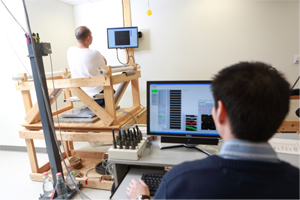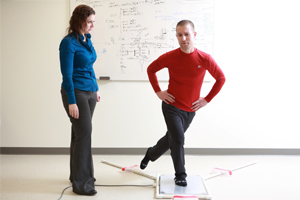Research Spotlight: Core Stability and Shoulder Injury
July 14, 2014
 Faculty and doctoral students in the Department of Physical Therapy and Rehabilitation Sciences and the Department of Health Sciences have embarked on a research study looking at possible associations between athletes’ core stability and shoulder injuries. Sheri Silfies, an associate professor and Research Lab Coordinator, David Ebaugh, an associate clinical professor, and PhD students Marisa Pontillo and Courtney Butowicz are working collaboratively to address a gap in the current literature related to core stability and its role in shoulder injuries in athletes. So far, this area of research has focused largely on core stability and injuries to the lower extremities, especially at the knee and ankle. Their study, which was funded by the American Physical Therapy Association’s (APTA) Sports Section’s Legacy Fund, will compare lab based and clinical measures of core stability in athletes with and without shoulder injuries.
Faculty and doctoral students in the Department of Physical Therapy and Rehabilitation Sciences and the Department of Health Sciences have embarked on a research study looking at possible associations between athletes’ core stability and shoulder injuries. Sheri Silfies, an associate professor and Research Lab Coordinator, David Ebaugh, an associate clinical professor, and PhD students Marisa Pontillo and Courtney Butowicz are working collaboratively to address a gap in the current literature related to core stability and its role in shoulder injuries in athletes. So far, this area of research has focused largely on core stability and injuries to the lower extremities, especially at the knee and ankle. Their study, which was funded by the American Physical Therapy Association’s (APTA) Sports Section’s Legacy Fund, will compare lab based and clinical measures of core stability in athletes with and without shoulder injuries.
The research team has defined an “athlete” as someone who regularly engages in ten or more hours of physical training per week and participates in club, intramural, varsity, and self-guided athletics. They are actively seeking subjects over the age of 18 through the mid-twenties with current shoulder injuries. Athletes without shoulder injuries are also being recruited, and will be matched by sport and gender to those athletes with a current shoulder injury.
The testing protocol includes both lab and clinical components that assess core and shoulder function. Using a device that the group constructed themselves, they also collect isolated measures of core control. Silfies originally constructed and developed the seated testing protocols to test core control in individuals with low back pain. “We build much of our own research equipment and try to be as self-sufficient as we can,” elaborated Ebaugh. Their research subjects additionally participate in standing balance tests (one static and one dynamic), endurance tests, and functional tests for athletes in order to get a complete picture of their core stability.
As advisors in the process, Drs. Ebaugh and Silfies created the structured approach while doctoral students Pontillo and Butowicz conducted the literature review. Together the team then developed their testing methodology. They all spent time in the lab “developing a standardized protocol, a written manual and training procedures for all of the testing protocols,” according to Silfies.
This study is unique not only in that it addresses a significant gap in the research, but also because the team created their own screen that expands upon an already popular screen for athletes: the Functional Movement Screen (FMS). Butowicz was instrumental in creating the new comprehensive screen and instructional manual, with input from physical therapists from Drexel University’s Physical Therapy practice. The current study will also be a means for pilot testing the newly developed screening tool so that others can replicate the procedure in the future.
 “I think people underestimate the amount of time it takes to develop and implement research projects,” said Ebaugh. The group of four has been working together for the past year and has just recently begun accepting athletes as subjects for the study.
“I think people underestimate the amount of time it takes to develop and implement research projects,” said Ebaugh. The group of four has been working together for the past year and has just recently begun accepting athletes as subjects for the study.
Drexel’s College of Nursing and Health Professions is arguably the only place where this study would have taken place, as all of the ingredients needed came together through the unique research team. Ebaugh’s passion for the shoulder, Silfies’ expertise in low back pain and core stability, Pontillo’s interest in athletes with shoulder injury, and Butowicz’s fitness perspective created the ideal team with the ability to approach the topic from different perspectives. Drs. Ebaugh and Silfies have even been working together at Drexel for the past 18 years.
Another unique facet of this research study is that it is a combination of both clinical and biomechanical tests. The results should be relevant and translatable to clinicians seeing patients with shoulder injuries. Based on the forthcoming results, the research team may be able to say that certain individuals are at higher risk for shoulder injury based on the amount of core stability they demonstrate. Can we select screening tests to identify at-risk athletes? This could be a launching off point for further study.